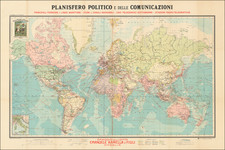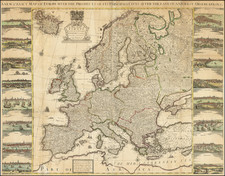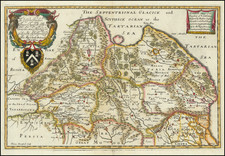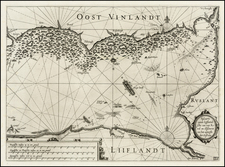Striking Early-Twentieth Century Japanese Satirical Map of Europe
Fine example of Kisaburō Ohara's satirical “Octopus Map” of Europe, published in Japanese and English.
The map was created at the outbreak of the Russo-Japanese War (1904 - 1905), in the style of J.J. van Brederode (“Humoristische-Oorlogskaart”, 1870) and Fred Rose (“Serio-Comic War Map”, 1877). These two maps established the serio-comic style of mapmaking, which is on display here.
Whereas Brederode and Rose focus upon Russia, Ohara has expanded the idea to encompass all of Eurasia. Russia's eight grasping tentacles extend across Europe and Asia; on many countries they already have a firm grip.
As the English text box in the upper left explains, this map was made at the beginning of the Russo-Japanese War (1904-1905). Made in 1904, this map was made a month after hostilities broke out. Ohara sums up the situation from a Japanese Imperial perspective:
Black Octopus is a name newly given to Russia by a certain prominent Englishman. For the black octopus is so avaricious, that he stretches out his eight arms in all directions, and seizes up every thing that comes within his reach. But as it sometimes happens he gets wounded seriously even by a small fish, owing to his too much covetousness. Indeed, a Japanese proverb says: 'Great avarice is like unselfishness.' We Japanese need not to say much on the cause of the present war. Suffice it to say that the further existence of the Black Octopus will depend entirely upon how he comes out of this war. The Japanese fleet has already practically annihilated Russia's naval powers in the Orient. The Japanese army is about to win a signal victory over Russia in Corea and Manchuria. And when ... St. Petersburg? Wait & see! The ugly Black Octopus! Hurrah! Hurrah! for Japan.
The inclusion of Japanese and English reveals this map to be intended for both a Japanese and an English, or more broadly European, audience. It shares a Japanese view of Asia—in terms of the geographical representation of central Asia, it is noteworthy that China's borders are not that of Qing China, but rather are severely limited, excluding Chinese claims to Tibet and Turkestan—and suggests that European countries should support, and at least not interfere in, Japan’s dispute with Russia. At this time, Japan had an alliance with Britain, for example, and that accord kept France, Russia’s ally, out of the Russo-Japanese War.
The Russo-Japanese War
At the dawn of the twentieth century, both Russia and Japan were seeking to expand their territorial empires and influence in Asia. Russia especially sought a warm-water port in the Pacific Ocean, while both countries sought influence, resources, and land on the Asian continent.
Russia leased a port on the Liaodong Peninsula of China called Port Arthur; however, they preferred to have the port in permanent Russian hands. Russia had also backed China in a dispute with Japan, the First Sino-Japanese War of 1895. Both of these actions were seen as aggressive by the Japanese. Russia, in their turn, were concerned about Japan’s influence and presence in Manchuria and the Korean Peninsula.
The two powers sought to negotiate through their difficulties, but the negotiations broke down in early 1904. Then, the Japanese staged a surprise attack on the Russian Navy stationed at Port Arthur on February 8, 1904. Japan then began bombarding the port, with both combatants laying mines to damage enemy ships. This was the situation when this map was made in March 1904.
The conflict continued with land battles over the summer of 1904. By the end of the year, the Japanese had sunk the entirety of Russia’s fleet in Port Arthur. The garrison surrendered in January 1905. Meanwhile, Japanese troops had taken the Korean Peninsula and were poised to attack Russian-controlled Manchuria. In February and March 1905, at the Battle of Mukden, the Japanese pushed the Russian troops back overland.
In response to these losses, Russia ordered its Baltic Fleet to reinforce its sunken squadron at Port Arthur. It arrived in May 1905, headed for Vladivostok. The Japanese discovered them and engaged them at the Battle of the Tsushima Straits on May 27, 1905. They sunk all but three of the Russian ships, forcing the Russians to seek peace talks.
Mediated by US President Theodore Roosevelt, the parties agreed to the Treaty of Portsmouth on September 5, 1905. Russia gave up Port Arthur to Japan, but kept the northern half of Sakhalin Island. They also had to leave Manchuria, while Japan kept control of the Korean Peninsula.
The war, which some historians refer to as World War Zero, marked the first time that an Asian country had defeated a European country in modern military combat. This map reflects the awareness Japan had of its place in global politics, especially with regard to Europe.
Rarity
This map was drawn by Ohara while a student at Keiō Gijuku University. It was published by Suketarō Nishida. The map is rare by any standard, with only two institutional collection examples identified by the OCLC.









![[ Hawaii ] Free All Islands Map](https://storage.googleapis.com/raremaps/img/small/99157.jpg)
![Newsmap. Monday, July 27, 1942 [on verso:] Tanks of the British Army](https://storage.googleapis.com/raremaps/img/small/93349.jpg)



